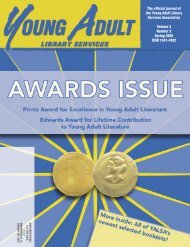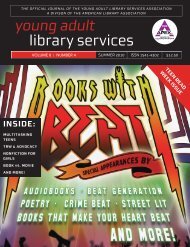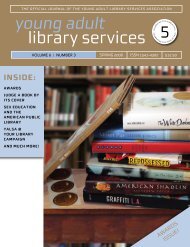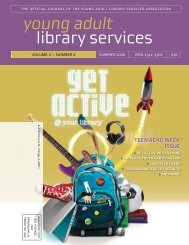Spring 2007 - YALSA - American Library Association
Spring 2007 - YALSA - American Library Association
Spring 2007 - YALSA - American Library Association
Create successful ePaper yourself
Turn your PDF publications into a flip-book with our unique Google optimized e-Paper software.
arriers to glbtq collection developmentTable 1. Survey One—Types Of GLBTQ <strong>Library</strong>MaterialsNo. of Respondentsmaterials of any type, and one respondentindicated that they do have these materials,but that they are mixed in with all of theother young adult materials.Of the large majority who indicatedtheir libraries do own GLBTQ materials,many reported owning books and periodicals,and about 10 percent listed teenadvisory boards (see table 1). Additionalresources cited were DVDs, GLBTQbooklists, GLBTQ committees, bookmarks,and a special collection made up ofexclusively GLBTQ-themed children’s andyoung adult books.When asked if their library had anyspecific programs for GLBTQ youngadults, 93 percent of the respondentsindicated they did not have any programsspecifically for GLBTQ teens, while 7 percentsaid they do have programs (see table2). The most frequently cited reason fornot having teen programming specificallyfor this population was “our YA programmingis for all teens, not just GLBTQteens,” with about one-fourth of therespondents citing this reason. The secondmost frequently cited reasons were “Thereis no interest and/or demand for theseprograms in our community” and “studentgroups or outside agencies fill this role.”Ten librarians said, “our library has no programmingat all,” and ten said, “our libraryhas inadequate staff and/or no administrativesupport for this programming.” Thosewho did have teen GLBTQ programslisted displays, materials to support speakers,gay-straight alliance (GSA) meetingswith speakers, films, diversity clubs, teenadvisory groups, and computer clubs. Themost successful programs included: diversity/anti-bullyingworkshops, in-serviceworkshops for teachers and librarians,author visits, general weekly social gatheringswith food, and programming relatedto graphic novels.Results of Survey TwoThis survey focused on challenges toGLBTQ-themed materials for youngadults and received fifty responsesfrom librarians in twenty-three states.Demographics for the group showed thatmost of the respondents were in California(14 percent), Arizona (10 percent), andNew York and Florida (8 percent each).Twenty-nine respondents were from publiclibraries and five were from school librarieswhile twelve respondents failed to indicatelibrary type. Forty-three respondents(86 percent) indicated they had not hadchallenges to these materials and seven(14 percent) indicated that they have hadchallenges. Of the seven who admittedchallenges, four respondents from publiclibraries in Tucson, Arizona, stated thatthey had strongPercent of Total1–40 books 47 55.341–75 books 24 28.276+ books 14 16.5Total (books) 85 1001–5 periodicals 18 21.26+ periodicals 1 1.2Teen advisory board 8 9.4Other (please specify) 15 17.6administrativesupport for theirmaterials and thechallenges wereoverturned. Alibrary in Floridaindicated thata committeeaddressed theconcerns aroundthe challenge andthe final resultwas listed as“compromise.”A public library in Indiana indicated thatthe challenge was internal and the bookwas moved to the adult section. Finally, alibrary in Tampa, Florida, indicated thatthe challenge resulted in a countywide banof gay pride displays.Principal reasons given by those whoworked in libraries where GLBTQ materialshad never been challenged (see table3) included: liberal/urban environment(28 percent); patrons do not know thematerials are there (23 percent); strongadministrative support for GLBTQ books(9 percent); low profile of the materials (9percent); and parents do not know whattheir kids are reading (6 percent).DiscussionIn Survey One, the responses to “Whydoesn’t your library have GLBTQ materials?”and “Why doesn’t your library haveany GLBTQ programs?” merit furtherdiscussion. For example, there is an abundanceof evidence in the literature indicatingthat the GLBTQ population, althoughnot always visible, makes up a significantportion of library users in all areas of theUnited States. Unfortunately, the beliefthat there is no demand for GLBTQthemedmaterials or programming isrevealed by Survey One. Additionally, theresponses to these items are consistentwith what the literature calls self-censorship,censorship by omission, or internalcensorship.The lists of successful GLBTQ programmingprovide excellent examples oflibrary services of which the GLBTQ communityis in desperate need. For example,diversity and anti-bullying workshops canpromote tolerance and combat the bullyingepidemic in schools. Staff workshops cancorrect the misinformation and prejudicethat still exists among library professionals,and weekly social gatherings can alleviatethe isolation among GLBTQ teens that46 YALS | Young Adult <strong>Library</strong> Services | <strong>Spring</strong> <strong>2007</strong>









